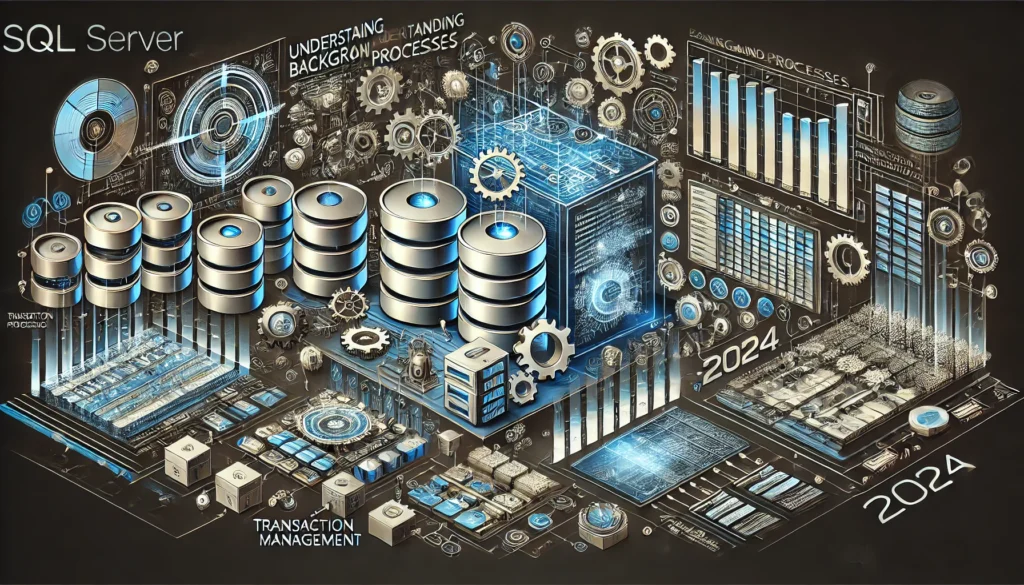Understanding the Background Processes of SQL Databases 2024 http://Understanding the Background Processes of SQL Databases 2024

Introduction
SQL databases are complex systems that handle data management, queries, and transactions efficiently. Behind the scenes, these databases rely on various background processes that ensure smooth operation, optimal performance, and data integrity. Understanding these background processes is essential for database administrators and developers who want to optimize and maintain database performance.
In this blog, we will delve into the core background processes of SQL databases, focusing on their roles, interactions, and contributions to the overall functionality of the database system.
1. Log Writer (LGWR)

Role: The Log Writer is a critical process responsible for writing redo log entries from the redo log buffer to the physical redo log files on disk. This ensures that any changes made to the database are recorded and can be recovered in the event of a failure.
How It Works:
- The LGWR writes entries to disk when a transaction commits.
- It also writes logs periodically, based on buffer space and database triggers.
- The process guarantees data integrity by ensuring that changes are written to logs before being committed to the database.
Benefits:
- Ensures data durability in case of system failure.
- Supports database recovery during crash recovery scenarios.
2. Database Writer (DBWR)

Role: The Database Writer process manages the movement of modified (dirty) blocks from the buffer cache to the data files on disk. This process helps maintain a balance between data retention in memory and long-term storage.
How It Works:
- The DBWR process is triggered when the buffer cache becomes full, checkpoints occur, or specific thresholds are met.
- It uses algorithms like the Least Recently Used (LRU) to decide which data blocks to write to disk.
Benefits:
- Helps maintain optimal memory usage.
- Ensures data consistency between the buffer cache and the database files.
3. Checkpoint Process (CKPT)

Role: The Checkpoint process coordinates the flushing of the dirty buffer cache to disk and updates the database files and control files with checkpoint information.
How It Works:
- The CKPT process signals the DBWR process to write data to disk.
- It updates the control file and data files with the most recent checkpoint position.
Benefits:
- Reduces recovery time by maintaining regular checkpoints.
- Ensures that recent data changes are regularly committed to disk.
4. System Monitor (SMON)
Role: The System Monitor is responsible for the recovery of the database instance in case of a crash or failure. It performs tasks such as instance recovery and cleaning up temporary segments.
How It Works:
- After a database crash, SMON automatically runs to recover the database.
- It applies redo logs to bring the database to a consistent state.
- It also reclaims space from temporary segments that are no longer needed.
Benefits:
- Automates database recovery processes, minimizing downtime.
- Ensures that unused space is returned to the database for reuse.
5. Process Monitor (PMON)
Role: The Process Monitor handles the recovery of failed processes and is responsible for cleaning up after user processes that fail to complete properly.
How It Works:
- PMON cleans up resources such as locks and memory used by failed processes.
- It restarts dead dispatcher processes and clears transactions left in an inactive state.
Benefits:
- Prevents system resource leakage.
- Ensures that locks and resources are released promptly to avoid performance issues.
6. Archiver Process (ARCn)
Role: The Archiver process is crucial for database backup and recovery in environments that use archiving. It copies redo log files to archival storage once they become full.
How It Works:
- ARCn runs in the background and continuously monitors redo log files.
- When a log switch occurs, the current redo log file is archived before being reused.
Benefits:
- Supports database point-in-time recovery by preserving historical data.
- Facilitates data backup strategies for disaster recovery.
7. Job Scheduler (DBMS_SCHEDULER)
Role: The Job Scheduler manages and executes scheduled jobs within the database. It is used for automated database maintenance, such as backups and performance monitoring.
How It Works:
- The Job Scheduler runs based on predefined schedules or event triggers.
- It executes scripts, stored procedures, or custom tasks as specified by the database administrator.
Benefits:
- Automates routine maintenance tasks to enhance efficiency.
- Reduces the need for manual intervention for recurring database operations.
Conclusion
Background processes in SQL databases form the backbone of efficient data management and transaction processing. Each process has a unique role that contributes to overall database stability, performance, and recovery capabilities. Understanding these processes helps database administrators monitor, troubleshoot, and fine-tune their databases for better performance and reliability.
Key Takeaways:
- Background processes such as LGWR, DBWR, CKPT, SMON, PMON, ARCn, and the Job Scheduler ensure that a database runs smoothly and can recover quickly from issues.
- These processes help maintain data consistency, optimize memory usage, automate recovery, and support data durability.
- A solid grasp of these components empowers database professionals to design better backup, recovery, and performance strategies.
By leveraging the knowledge of these background processes, database administrators can enhance their skills in maintaining high-performance and reliable database systems.